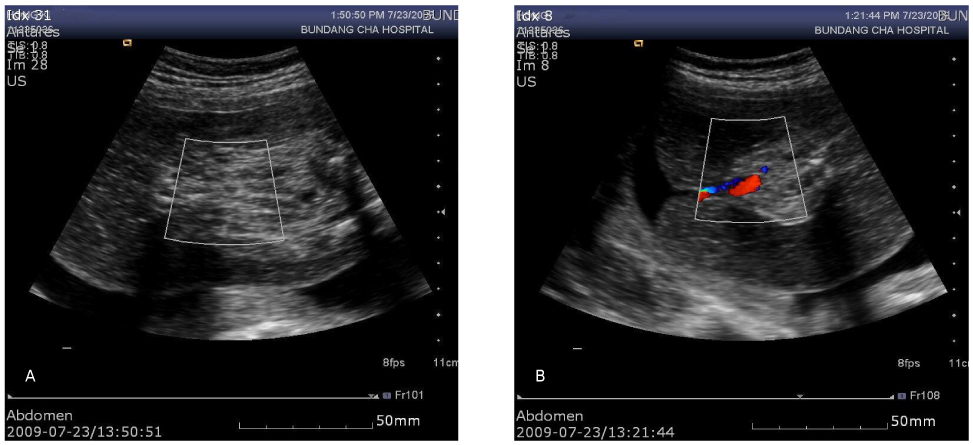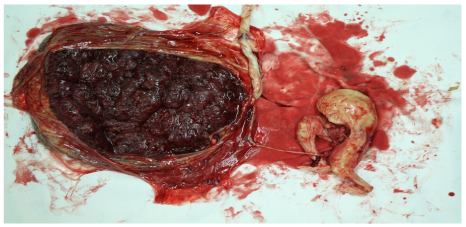Korean J Obstet Gynecol.
2010 May;53(5):449-454. 10.5468/kjog.2010.53.5.449.
A case of acardiac twin pregnancy with fetus survival after successful radiofrequency ablation of umbilical cord
- Affiliations
-
- 1Department of Obstetrics and Gynecology, CHA University, Bundang Cha Women's Hospital, Seoul, Korea. mmj33@hanmail.net
- KMID: 2273878
- DOI: http://doi.org/10.5468/kjog.2010.53.5.449
Abstract
- Acardiac twin is a rare anomaly that occurs 1% in monochorionic twins and 1 in 35,000 pregnancies overall. Acardiac twin, also known as twin-reversed arterial perfusion (TRAP) sequence, involves a "pump" or donor twin perfusing a recipient or "acardiac" twin through vascular (usually arterial-arterial and venous-venous) anastomoses. Perinatal mortality rate for the pump twin has been reported to be 50~75%, mainly as a result of polyhydramnios, preterm labor, and congestive heart failure. Therefore, occlusion of the circulation to the acardiac twin has been recommended to improve perinatal outcome of the pump twin. Radiofrequency ablation of the acardiac twin effectively protects the pump twin from high-output cardiac failure and death. We report our experience in the treatment of patients with TRAP sequence using radio frequency ablation to stop perfusion to the acardiac twin.
Keyword
MeSH Terms
Figure
Reference
-
1. Napolitani FD, Schreiber I. The acardiac monster. A review of the world literature and presentation of 2 cases. Am J Obstet Gynecol. 1960. 80:582–589.2. al-Malt A, Ashmead G, Judge N, Mann L, Ashmead J, Stepanchak W. Color-flow and Doppler velocimetry in prenatal diagnosis of acardiac triplet. J Ultrasound Med. 1991. 10:341–345.3. Sepulveda W, Bower S, Hassan J, Fisk NM. Ablation of acardiac twin by alcohol injection into the intra-abdominal umbilical artery. Obstet Gynecol. 1995. 86:680–681.4. Sogaard K, Skibsted L, Brocks V. Acardiac twins: pathophysiology, diagnosis, outcome and treatment. Six cases and review of the literature. Fetal Diagn Ther. 1999. 14:53–59.5. Sullivan AE, Varner MW, Ball RH, Jackson M, Silver RM. The management of acardiac twins: a conservative approach. Am J Obstet Gynecol. 2003. 189:1310–1313.6. Diehl W, Hecher K. Selective cord coagulation in acardiac twins. Semin Fetal Neonatal Med. 2007. 12:458–463.7. Pretorius DH, Leopold GR, Moore TR, Benirschke K, Sivo JJ. Acardiac twin. Report of Doppler sonography. J Ultrasound Med. 1988. 7:413–416.8. Healey MG. Acardia: predictive risk factors for the co-twin's survival. Teratology. 1994. 50:205–213.9. Quintero RA, Reich H, Puder KS, Bardicef M, Evans MI, Cotton DB, et al. Brief report: umbilical-cord ligation of an acardiac twin by fetoscopy at 19 weeks of gestation. N Engl JMed. 1994. 330:469–471.10. McCurdy CM Jr, Childers JM, Seeds JW. Ligation of the umbilical cord of an acardiac-acephalus twin with an endoscopic intrauterine technique. Obstet Gynecol. 1993. 82:708–711.11. Quintero RA, Romero R, Reich H, Goncalves L, Johnson MP, Carreno C, et al. In utero percutaneous umbilical cord ligation in the management of complicated monochorionic multiple gestations. Ultrasound Obstet Gynecol. 1996. 8:16–22.12. Ville Y, Hyett JA, Vandenbussche FP, Nicolaides KH. Endoscopic lasercoagulation of umbilical cord vessels in twin reversed arterial perfusion sequence. Ultrasound Obstet Gynecol. 1994. 4:396–398.13. Hecher K, Hackeloer BJ, Ville Y. Umbilical cord coagulation by operative microendoscopy at 16 weeks' gestation in an acardiac twin. Ultrasound Obstet Gynecol. 1997. 10:130–132.14. Arias F, Sunderji S, Gimpelson R, Colton E. Treatment of acardiac twinning. Obstet Gynecol. 1998. 91:818–821.15. Porreco RP, Barton SM, Haverkamp AD. Occlusion of umbilical artery in acardiac, acephalic twin. Lancet. 1991. 337:326–327.16. Lee Si Won, Lee Sun Ok, Park Mi Hye, Kim Young Ju, Chun Sun Hee, Ahn Jung Ja. Successful Management with Intra-abdominal Alcohol Ablation of Acardiac Twin and Amniodrainage in Twin Reversed Arterial Perfusion Sequence with Severe Polyhydramnios. Kor J obstet Gynecol. 2004. 47:1394–1399.17. Lee H, Wagner AJ, Sy E, Ball R, Feldstein VA, Goldstein RB, et al. Efficacy of radiofrequency ablation for twin-reversed arterial perfusion sequence. Am J Obstet Gynecol. 2007. 196:459. e1–459. e4.18. Tsao K, Feldstein VA, Albanese CT, Sandberg PL, Lee H, Harrison MR, et al. Selective reduction of acardiac twin by radiofrequency ablation. Am J Obstet Gynecol. 2002. 187:635–640.19. Bilchik AJ, Wood TF, Allegra DP. Radiofrequency ablation of unresectable hepatic malignancies: lessons learned. Oncologist. 2001. 6:24–33.
- Full Text Links
- Actions
-
Cited
- CITED
-
- Close
- Share
- Similar articles
-
- Acardiac Twin Diagnosed by Antenatal Ultrasonography: Report of Two Cases
- A Case Report of Heterokaryotypic Monochorionic Twin Pregnancy with Discordant for Turner Syndrome
- Tailored selective termination in second trimester in twin pregnancy
- Anesthesia for Fetal Surgery: Twin Reversed Arterial Perfusion Sequence
- A Case of Acardiac Parabiotic Twin



